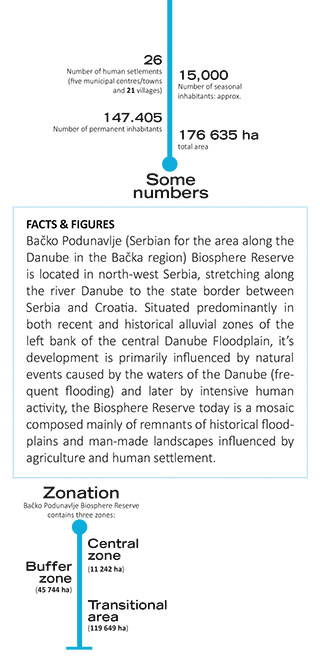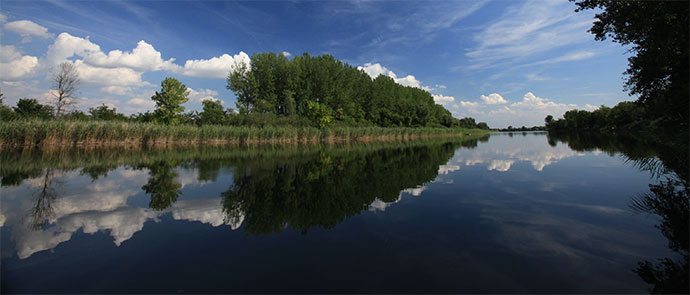Danube Watch 2/2017 - Bačko Podunavlje - Creating a piece of the Amazon in Serbia
Bačko Podunavlje - Creating a piece of the Amazon in Serbia
Biosphere finally gets green light


More than six years since the Ministerial Declaration concerning the Establishment of the Transboundary Biosphere Reserve (TBR) 'Mura-Drava Danube' (Gődőlo, Hungary, 2011), this international vision seems today much closer to becoming a reality.
T he International Coordination Council of UNESCO’s Man and Biosphere (MAB) Programme approved Bačko Podunavlje as a UNESCO Biosphere Reserve at its 27th session at the UNESCO Headquarters in Paris on 14th June 2017. This project, which is led and carefully managed by dedicated Serbian conservationists and scientists, is also supported by colleagues from four other countries. TBR has finally made a successful start after a not so smooth nomination and designation process. The nomination for the project was first sent by Serbian authorities to UNESCO in 2016, and was actually the third such submission for the same area of the Danube floodplains in North-West Serbia; the first was sent as far back as 2001 and the second in 2013, but both were unsucessful and approval was deferred.
“The synergy created by the various stakeholders for the project has proved to be very successful” says Dr. Biljana Panjković, Director of the Institute for Nature Conservation in the Vojvodina Province. This Institute coordinated the nomination process and has been declared the official management authority for the new biosphere reserve. The nomination was prepared by means of an extensive stakeholder consultation process and endorsed by state ministries, regional secretariats and sectors involved in the use of natural resources. The mayors from five local municipalities where the biosphere reserve is being established – Sombor, Apatin, Odžaci, Bač and Bačka Palanka – were also very active in this process. The nomination was finally submitted to MAB by the National Commission of the Republic of Serbia for cooperation with UNESCO by the Serbian Ministry of Foreign Affairs and afterwards actively promoted by the ambassador Dr. Darko Tanasković, the Head of Permanent Mission of Republic of Serbia to UNESCO and its associates.
The Transboundary UNESCO Biosphere Reserve will combine the cluster of thirteen protected areas along the Mura-Drava-Danube region and jointly manage the shared river ecosystem in a sustainable manner while boosting economic growth and development in the region.
Panjković pointed out that the project would not be effective without an extremely proactive attitude, crucial assistance and the catalysing role of the WWF and its director in Serbia Duška Dimović, whose vision of joint cooperation for the conservation of a European Amazon was extremely motivating throughout the process.

The biosphere reserve has three main functions:
Conservation The main natural values of the proposed reserve are concentrated in existing protected areas, which form part of the reserve. These protected
areas are:
- The Gornje Podunavlje Special Nature Reserve, which is a RAMSAR site and a conservation area containing internationally important wetlands. This is an important area for birds, plants and butterflies.
- The Karađorđevo Special Nature Reserve area, which is an important habitat for birds.
- The Tikvara Nature Park and the Junaković Fores Nature Monument.
The Biosphere Reserve also consists of areas which are part of the National Ecological Network along the rivers Danube and Mostonga. These areas are extremely important for the conservation of biodiversity at a national level. The area hosts more than 1,000 species of vascular plants, 57 fish species, 11 species of amphibians, 9 species of reptiles, 270 species of birds, 60 species of mammals and countless species of invertebrates, which all contribute to the general biodiversity of the entire river system of the Mura, Drava and Danube. Many species are on the Red List or are important at both national and international levels.
Development The area has the potential to serve as a site of excellence and a model region for promoting sustainable development. Forestry measures in the area are carried out by the Vojvodinašume Public Enterprise, which has had a certified system for the production of timber (FSC certificate SGS-FM/COC-005064) since 2008. Tourism is another sustainable economy. This relies on the extensive available natural potential of the area, but still lacks any serious promotion. Eco-tourism offers a significant number of options for visitors. These include both rural and nautical tourism such as horse riding, recreational fishing, hunting, bathing and cycling. The Gornje Podunavljre Special Nature Reserve was granted The European Charter for Sustainable Tourism in Protected Areas (ECSTPA) in 2014.
Logistics Thanks to the favourable surroundings and three university centres in the vicinity (Novi Sad, Osijek and Pecs), as well as a proactive scientific and expert community, the area is a demonstration site for a large number of research projects, initiatives and actions. Many of these are financed by European Union IPA Cross-border cooperation programmes between Hungary and Serbia, Croatia and Serbia and the Danube Transnational Programme.







